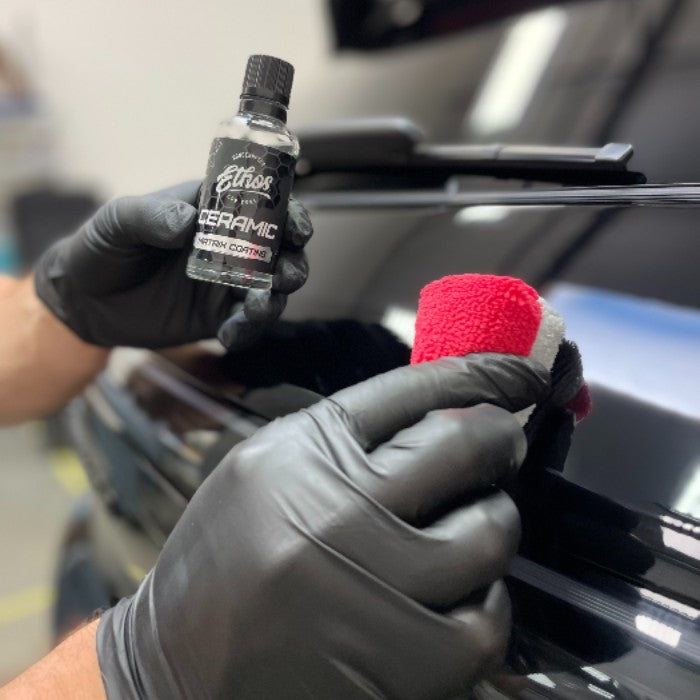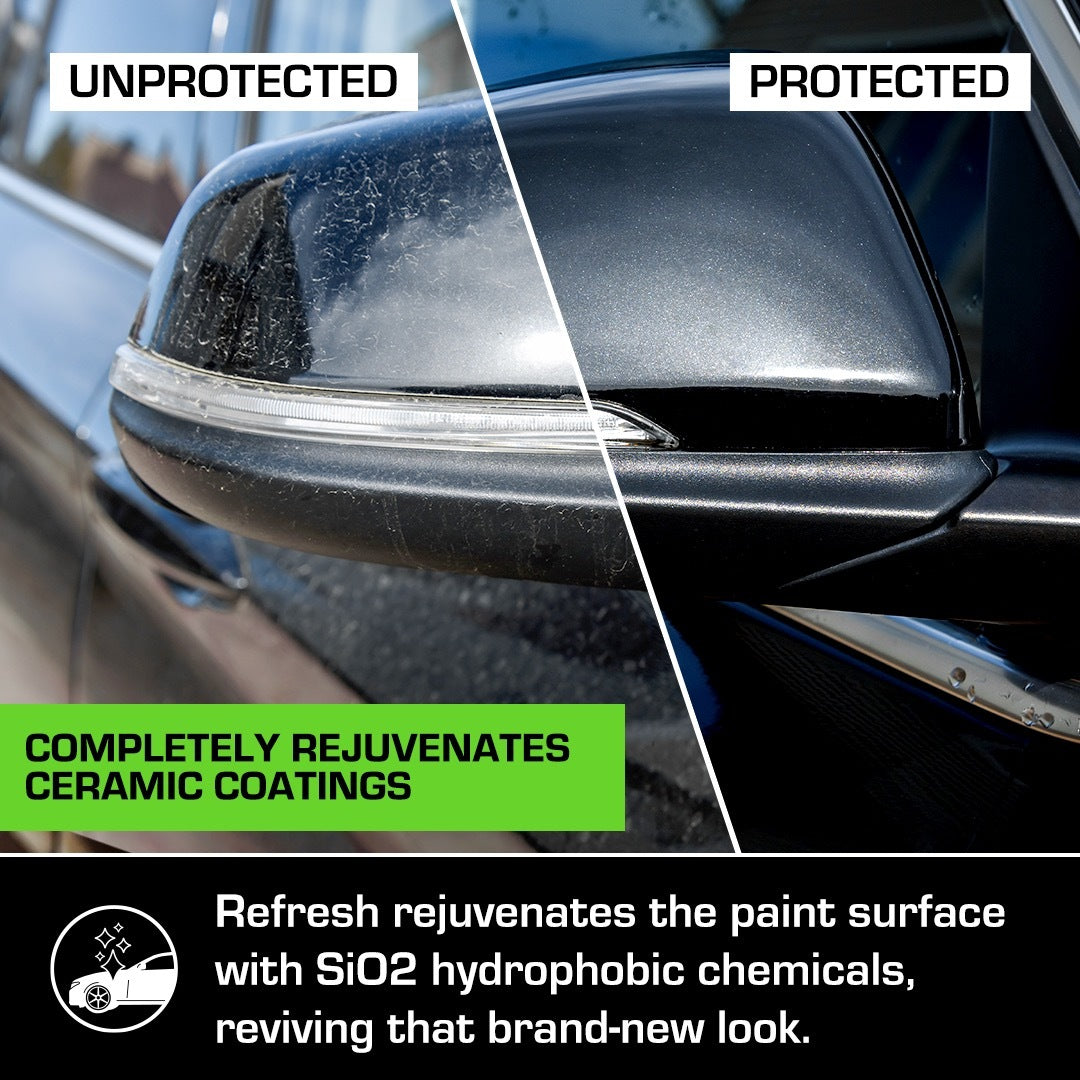The top mistakes to avoid with Ceramic Coating Newark
Wiki Article
Exploring the Scientific Research Behind Car Ceramic Coating and Its Protective Qualities
The science of car ceramic coating presents an interesting study in sophisticated automotive defense. Composed largely of silicon dioxide and polymers, these coatings form a durable bond with car paint. This communication improves toughness against environmental threats while supplying hydrophobic advantages. Nevertheless, the ins and outs of just how these finishes work and their lasting advantages continue to be less comprehended. Unloading these information exposes why ceramic coverings are ending up being a favored option for automobile treatmentWhat Is Ceramic Coating?
Ceramic coating is a liquid polymer that chemically bonds to the surface of a lorry's paint. This advanced safety layer enhances longevity and uses exceptional resistance to ecological aspects. Unlike standard wax or sealants, which offer short-term defense, ceramic coatings create a resilient guard that can hold up against extreme conditions such as UV rays, acidic impurities, and severe weather. When used correctly, the coating develops a hydrophobic surface, creating water to bead and slide off, which aids in keeping the lorry's sanitation. In addition, it uses improved gloss and depth to the paint, making the automobile appear even more sleek and vibrant. The application procedure commonly entails comprehensive surface preparation, consisting of cleaning and sprucing up, to assure peak bonding. Therefore, ceramic finishings are ending up being significantly preferred among car fanatics and those looking for to secure their financial investments, assuring to keep the lorry's visual appeal while decreasing the frequency of maintenance.The Structure of Ceramic Coatings
The detailed formulation of ceramic coatings mainly includes silicon dioxide (SiO2), which is originated from all-natural sources like quartz and sand. This essential part provides the structure for the coating's sturdiness and protective top qualities. Along with SiO2, ceramic coverings commonly consist of different polymers and additives that enhance bond, adaptability, and resistance to environmental aspects. These compounds function synergistically to create a durable barrier versus contaminants such as dust, chemicals, and UV rays.Furthermore, some formulas include titanium dioxide (TiO2) or other nanomaterials, which can enhance the coating's hydrophobic residential properties, leading to improved water repellency. The accurate make-up can vary considerably among makers, influencing efficiency and longevity. Ultimately, the mix of these components finishes in a protective layer that not just enhances the visual appeal of vehicles but likewise offers to lengthen their life-span by shielding the surface area from prospective damages.Just How Ceramic Coatings Job
Recognizing exactly how ceramic finishings function entails discovering their chemical make-up, which adds to their safety top qualities. The application process is necessary for achieving perfect results, while longevity and longevity aspects figure out the coating's efficiency in time. Together, these components highlight the advantages and efficiency of ceramic layers for lorry defense.Chemical Composition Explained
While numerous car owners look for durable protection for their cars, the chemical structure of ceramic coverings plays an important function in their performance. These finishings mainly include silicon dioxide (SiO2), which is stemmed from all-natural minerals. This substance develops a strong bond with the lorry's paint, producing a durable, safety layer. In addition, many ceramic coverings consist of titanium dioxide (TiO2), improving their hydrophobic residential properties and resistance to UV rays. The existence of polysiloxanes can additionally boost versatility and sturdiness. With each other, these components contribute to the coating's capacity to push back water, dirt, and pollutants, while also supplying a high-gloss coating. Recognizing this chemical foundation aids car owners appreciate the robust protection offered by ceramic coverings.Application Process Review
Using ceramic coverings includes a thorough process that guarantees perfect bonding and security for the automobile's surface area. Comprehensive cleansing and purification of the car's outside are executed to get rid of dust, gunk, and previous waxes. This step confirms that the surface is complimentary from contaminations that can hinder adhesion. Following this, the paint is commonly polished to boost clearness and get rid of any kind of imperfections. Once prepared, the ceramic coating is applied in small areas utilizing an applicator pad, enabling for consistent insurance coverage. The coating is then left to heal, developing a strong chemical bond with the surface. Appropriate treating times and conditions are critical, as they verify the coating accomplishes its maximum efficiency and safety top qualities.Long Life and Durability Aspects
Ceramic finishings are developed to give resilient defense via their sophisticated chemical composition, which develops a durable obstacle against environmental contaminants. The these details sturdiness of these layers is influenced by factors such as the density of the application, the high quality of the item, and the conditions under which the car is subjected. Top notch ceramic coverings can last numerous years, standing up to scrapes, UV rays, and chemical discolorations. Appropriate maintenance, including regular washing and routine reapplication, can better enhance durability. In addition, ecological variables like environment and direct exposure to pollutants can affect the lifespan of the coating. Generally, when used and maintained properly, ceramic coverings offer exceptional sturdiness, making them a prominent selection for car fanatics seeking to preserve their vehicle's look.Hydrophobic Residences and Water Repellency
Hydrophobic homes are a hallmark of quality car ceramic coatings, significantly boosting the vehicle's surface efficiency. These layers create a molecular bond with the car's paint, causing a surface area that fends off water successfully. When water enters call with a ceramic-coated surface area, it beads up and rolls off, lessening the amount of fluid that stays on the paint. This habits not only adds to a cosmetically pleasing appearance yet likewise decreases the buildup of pollutants such as dirt, grime, and roadway salts.The enhanced water repellency leads to simpler cleansing and upkeep, as much less effort is required to remove undesirable substances. On top of that, the hydrophobic nature of ceramic finishes aids in avoiding water areas, which can mar the surface of uncoated surface areas. Generally, the consolidation of hydrophobic properties in ceramic finishings plays an essential function in maintaining the automobile's pristine look while streamlining upkeep.Protection Against Scratches and UV Damages
Car ceramic finishes use substantial defense against scrapes and UV damage. The scrape resistance system creates a resilient layer that absorbs influences, while the UV shielding advantages assist keep the car's paint honesty over time. Together, these features add to a longer-lasting and visually attractive coating.Damage Resistance Device
Using advanced technology, ceramic layers offer a durable shield versus scrapes and UV damage, boosting the longevity and look of car surfaces. The scrape resistance system of these finishings is attributed to their unique molecular structure, which creates a resilient bond with the car's paint. This bond creates a hard, protective layer that can soak up Continue impacts and resist abrasions. Additionally, the smooth surface area of the coating reduces friction, making it difficult for impurities to adhere and cause scrapes. The chemical make-up of ceramic finishes often includes nanoparticles that reinforce the safety layer, more boosting its strength. Subsequently, automobiles treated with ceramic finishes display considerably boosted scrape resistance compared to traditional wax or sealers, ensuring a pristine coating in time.UV Shielding Conveniences
The safety qualities of ceramic layers extend past scrape resistance to include significant UV shielding benefits. These finishings develop a durable barrier that mirrors hazardous ultraviolet rays, safeguarding the vehicle's paint and underlying products. Long term direct exposure to UV radiation can result in fading, oxidation, and degeneration of the paint coating. By incorporating ceramic layers, vehicle owners can effectively alleviate these risks, maintaining the visual appeal and honesty of their vehicles. Furthermore, the UV blocking residential properties add to improved longevity, reducing the regularity of repainting and upkeep. Ultimately, the integration of ceramic finishings provides an extensive option for securing lorries from the destructive effects of sun exposure, making sure a continual, vibrant appearance with time.The Long life and Maintenance of Ceramic Coatings

Regularly Asked Questions
Can Ceramic Coating Be Applied to Any Type Of Kind Of Car?
Ceramic coating can be put on various sorts of lorries, consisting of autos, vehicles, and bikes. Nonetheless, surface click for info prep work and compatibility with certain products are vital for suitable bond and effectiveness of the coating.Exactly How Much Does Ceramic Coating Usually Price?
Ceramic coating usually sets you back between $500 and $2,000, depending on factors such as automobile size, coating high quality, and expert application. The investment can supply resilient protection and improve the vehicle's look gradually.
Is Professional Application Essential for Ideal Outcomes?
The requirement of expert application commonly depends on preferred results. Specialists normally guarantee correct surface preparation and application methods, resulting in ideal bonding and longevity of the coating, which might be challenging for inexperienced people to achieve.Can Porcelain Coatings Be Gotten Rid Of or Repaired?
Ceramic finishes can be gotten rid of or repaired, though the procedure may require particular solvents or techniques - Ceramic Coating Newark. Correct removal is important to avoid damages to the underlying surface, emphasizing the value of professional support for ideal resultsExactly How Does Porcelain Coating Contrast to Standard Wax?
The comparison in between ceramic coating and standard wax exposes that ceramic coverings supply premium sturdiness, improved defense against environmental pollutants, and longer-lasting sparkle, while wax calls for more regular application and provides much less overall resistance to damages.Report this wiki page